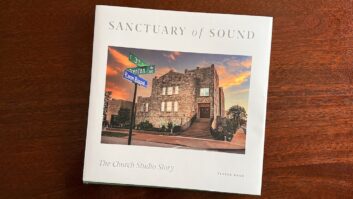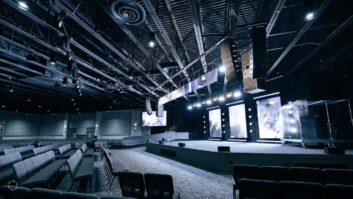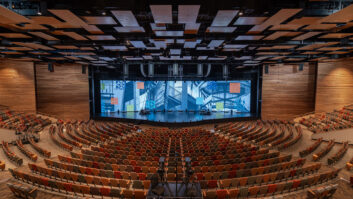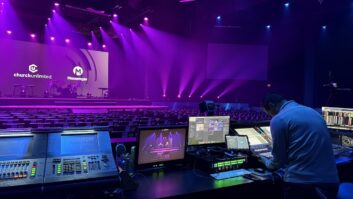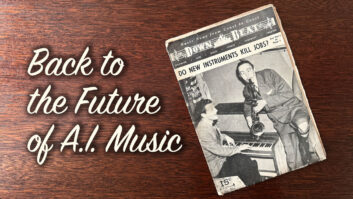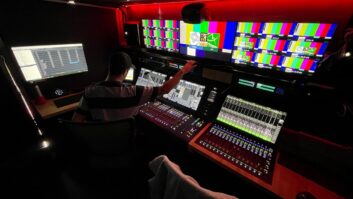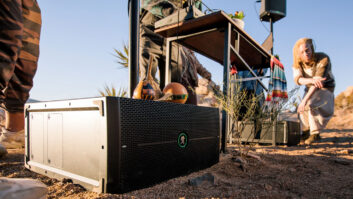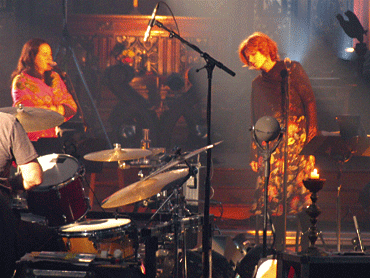
Trinity Revisited sessions” />
Natalie Merchant and Margo Timmons during the Trinity Revisited sessions
Photo: M. Godfrey
Twenty years ago, an album called The Trinity Session put a largely unknown Canadian band with the unlikely name of the Cowboy Junkies firmly on the musical map. Their music was intimate, languorous and seductive — almost like country-folk chamber music. Anchored around four Timmins siblings — leader/guitarist/songwriter Michael, guitarist John, drummer Peter and the mesmerizing singer Margo — along with bassist Alan Anton and a few musical friends, the album served up a haunting blend of originals and dreamy, achingly slow covers of such tunes as Hank Williams’ “I’m So Lonesome I Could Cry” and Lou Reed’s “Sweet Jane” (their FM radio breakout). The album was recorded live by engineer/producer Peter Moore in Toronto’s beautiful Church of the Holy Trinity during the course of one 12-hour session using just a single stereo microphone plugged into a DAT recorder; remarkably, the recording has real presence and it captures the ambience of the old church.
That album turned out to be a jumping-off point for what has been a rich and rewarding career for the Cowboy Junkies. During the course of a dozen studio albums since, the group (always featuring at least Michael, Peter and Margo Timmins, and Alan Anton) has succeeded in creating its own oeuvre, and a catalog peppered with brilliant original songs and absorbing interpretations of others’ tunes. Still, The Trinity Session is such an important part of their legacy it’s not too surprising that the group agreed to revisit that classic recording. And so, over two days in November 2006, the band and a trio of special guests returned to the Toronto landmark and recorded new versions of all the songs on The Trinity Session — this time with many microphones and a slew of outboard gear to multitrack Pro Tools — and with a full HD video crew on hand to capture the magic for a brilliant DVD and CD called Trinity Revisited, which came out in October in Canada and is being released in the U.S. later this month on the Rounder label. The package contains both the video and audio versions, plus a superb documentary about the making of The Trinity Session and its update two decades on.
More a celebration and reinterpretation of the original album than a re-creation, Trinity Revisited is a wonderfully realized work from every perspective — “a different thing with the same songs,” as Peter Timmins puts it in the documentary. Though many of the tunes on the album have been part of the group’s live repertoire for the better part of two decades, the decision to bring in three idiosyncratic “outsiders” — all fans of the band and The Trinity Session album — ended up having a huge impact on the music: Singer Natalie Merchant blends wonderfully well with Margo and Michael Timmins and sings some leads; Ryan Adams brings an unpredictable edge as both a guitarist and singer; and singer/guitarist Vic Chesnutt is utterly unique. And then there is multi-instrumentalist Jeff Bird, who’s been a part of all the band’s studio albums from The Trinity Session on, and is an essential part of the CJ “family” — his contributions are varied and vital throughout.
There are some risky choices made in these arrangements, but every single one pays off. Both visually and aurally, Trinity Revisited is a stunning achievement: The church is lighted in ways that make it look different in almost every shot, while the band is captured in crystal-clear close-ups and well-framed groupings; meanwhile, every whispered vocal, soaring harmony, every string rattle, brushed snare and reverbed amp tone matches the clarity and beauty of the picture. (In fairness, I should not say that not all Cowboy Junkies purists are happy with the contributions of the guests. I’m not a purist, however.)
Spearheading the making of Trinity Revisited were brothers Francois and Pierre Lamoureux, owners of the Montreal-based company FogoLabs, who specialize in this sort of high-quality production. “FogoLabs is a private facility with just 12 employees, and everything is catered toward live music production,” Francois Lamoureux explains. “We go around the world doing these shows, like the Cowboy Junkies, and it’s end to end, so the team here books the facility, does the lighting and we have all the video equipment. Having a full HDCAM SR online in-house makes life easier. We do all the audio production and we post it here, as well.”
Francois Lamoureux started Fogo as a mixing studio, “but now Pierre is with me full-time and we are joined at the hip. We have always worked together, but for a few years he was running a company called Enliven Entertainment, which would produce a lot of shows and then would hire FogoLabs to do the post-production. Pierre directs and produces most of everything we do. But I do not work with him because we are brothers; I work with him because I really do believe he is one of the best in the world at what he does.”
According to Francois Lamoureux, FogoLabs developed as it did in part because “we got fed up because the video people would always treat audio people like crap. We’d always get these tapes that wouldn’t work and the timecode was all wrong, and so we decided we were going to buy all the gear ourselves and try to do these [productions] from top to bottom. I stole an employee from Technicolor — an Avid specialist — and got him onboard here and never looked back. So here, audio controls video, which is very rare; I don’t know of any other post place where audio is king.”
FogoLabs has a number of exceptional projects under its belt, including ones featuring The Who, Harry Connick Jr., Zappa Plays Zappa, Damien Marley, Aimee Mann, Brian Setzer, Branford Marsalis, the Warped Tour and many more. Additionally, the company has archived all 1,200 tapes in the Canadian band Rush’s live and studio catalog.
“The Cowboy Junkies was a labor of love for us,” Francois Lamoureux says, “and a different sort of thing because typically we do live performances, and though this was live, it had no crowd. Having a crowd changes things because you can’t really start over. Still, with the Cowboy Junkies, I said, ‘Guys, I don’t want to do 50 takes.’ And they didn’t — they were really, really good. I think we did one or two takes of each song. We kept it as if it was really live, and it was a difficult thing to do because they hadn’t been back in the church for 20 years and that original album was very special for them — and, of course, it was recorded with one microphone.
“We weren’t going to try that, but what I decided to do was at least be faithful to that idea, so I got a [Holophone H2-PRO] surround microphone and I put all the guys in a circle, and then I augmented that with close-miking. I used it for Branford Marsalis on A Love Supreme, and it was fantastic. In that one, most of what you hear is the Holophone and it’s pretty stunning musically. With the Cowboy Junkies, I didn’t know what was going to happen with the Holophone in the church. It sounded great, but it really picked up too much ambience; it was too live, so I couldn’t use just that. In the stereo version, there’s not that much of the Holophone in there — probably about 10 to 15 percent. There’s a lot more on [the surround version].
“For the close mics, I used a bunch of Shure mics — the KSM Series, which I didn’t know very well before I heard about them from Paul at the Record Plant [Remote] when we did an Aimee Mann special. He’s the one who told me to check out these mics, and then when I was going to do the Cowboy Junkies, I wanted pristine mics, so I rented brand-new KSMs and they were fantastic — the 141 is a twist-capsule [condenser] where you can put it in omni, go 24-bit/96k and it sounds great.” Preamps used on the session were mostly API’s and some by Buzz — “If I had 48 of those, I would have used only those, but we had 10,” Francois Lamoureux says. “They have a lot headroom, so they really let things speak.”

FogoLabs arranged the musicians in a circle around a Holophone H2-PRO surround mic.
Photo: M. Godfrey
The band and their guests had a three-hour rehearsal the night before the shoot, and it turned out to be more than just running through the tunes. In the documentary, you see Adams making suggestions for the “out” on “Working on a Building”; indeed, everyone was involved in re-imagining the songs and breathing new life and fresh nuances into the material. “It was a very collaborative effort,” Francois Lamoureux offers. “I think you have to give the Cowboy Junkies a lot of credit for being so open to everyone’s ideas.” Then, it mostly became a matter of just capturing the performances as they went down.
“There are so many DVDs out there where everything is overdubbed,” Francois Lamoureux says, “whereas when we do things, I can only think of a couple where we had to overdub stuff, and two of them were because a wireless microphone died. Typically, we don’t overdub, so everything you hear the guys actually played. We went to great lengths — because it was so live in the church — to mike things properly. A lot of care was given — good cables and good outboard gear — but at the end of the day, great audio doesn’t make a hit album. But if you have fantastic audio, fantastic music and fantastic players, you get classics.”
You can see and hear the players and singers locking in on each song; the chemistry is palpable. The performances feel fresh, not overworked, so you can actually feel the arrangements coalescing. “It was a magical night,” Francois Lamoureux says without a hint of hype in his voice, just admiration. The old church “embraced” the music, Jeff Bird says.
In true Cowboy Junkies fashion, there’s very little in the way of flashy playing or musicians and singers calling attention to themselves. Yet the interlocking parts seem just about perfect, and there are so many little touches that make Trinity Revisited the masterpiece it is: Bird’s wah-wah mandolin on “Sweet Jane”; the elegant but soulful interweaving of Natalie’s, Margo’s and Ryan Timmins’ voices on “Misguided Angel”; the melancholy interplay of Bird’s fiddle and Merchant’s piano and vocal on “To Love is to Bury,” about which Francois Lamoureux comments: “That was challenging because we had to mike the violin and there were so many cameramen and so much noise because of all the people working, and everything was ambient-miked, so everybody had to be really quiet. That was the one I was most worried about, but Natalie has such a haunting voice and Jeff plays so beautifully.
“I think there’s a lot of spontaneity in this music,” he concludes, “and that’s because of who they are. The Cowboy Junkies have never stopped to analyze what makes them great. They just go and do it. There’s a lot of thought behind what they do, but they’re also not afraid to take chances or leave things open to chance. It was a risk going back to that church 20 years later, but they had the right approach and the right attitude.
“People have been listening to this music for 20 years, so they have their own opinions of how it ‘should’ sound, and probably also their own imagination of how the church looks. It’s hard because it’s like reading a novel and then the movie comes out. Is it going to be as good as your imagination? That’s the chance you take. I think it’s great they’re willing to take chances.”

